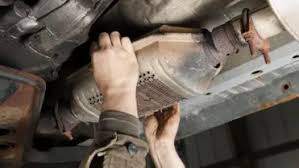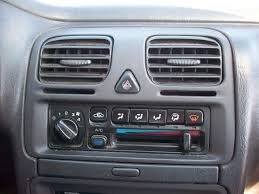How to clean a catalytic converter is subject of interest on this write up. Catalytic converter is a critical part of your vehicle’s emissions system. It turns toxic exhaust fumes into harmless gases and prevents them from polluting the air. A dirty or damaged catalytic converter can affect your vehicle’s fuel economy, acceleration and even cause an engine misfire. If you think your catalytic converter needs cleaning or replacement, here are some important steps to follow:
What is the Catalytic Converter?
Catalytic converters are one of the most important parts of a car. They convert harmful emissions into less dangerous ones, and they do this by using a chemical reaction with oxygen. The catalyst in catalytic converters is made up of precious metals such as platinum and palladium mixed with other elements like rhodium, iridium and ruthenium.
Catalytic converters are installed on vehicles to reduce air pollution from exhaust gases. They use oxidation to transform nitrogen oxides (NOx) into nitrogen gas (N2) or water vapor (H2O). In addition to converting harmful gases into harmless ones, catalytic converters also help reduce carbon monoxide (CO) emissions from gasoline engines by about 90%.
The life expectancy of your catalytic converter depends on several factors including driving habits, operating conditions and vehicle condition over time
How Does a Catalytic Converter Work?
A catalytic converter is a device that is located in the exhaust system of your car. It is made up of a honeycomb-shaped ceramic core that contains precious metals such as platinum and rhodium. The converter works by converting harmful gases into less harmful ones, thereby reducing pollution levels.
Catalytic converters are found after the muffler in a vehicle’s exhaust system and are typically made of ceramic or metallic elements that have been coated with precious metals, such as platinum and rhodium. These materials convert harmful gases into less harmful ones, resulting in cleaner emissions for your vehicle to produce when running on gasoline or diesel fuel.
Signs That Your Catalytic Converter Needs Cleaning
Signs of a dirty catalytic converter include:
- Increased fuel consumption
- Rough engine operation
- Poor acceleration and power output
- Excessive exhaust smoke or black smoke from the tailpipe (a sign of extremely poor performance)
How to Clean a Catalytic Converter
To clean a catalytic converter, remove it from the exhaust system and clean it in an ultrasonic cleaner or by placing it under running water. Cleaning with an ultrasonic cleaner is more effective than cleaning with water because an ultrasonic cleaner will dislodge and remove carbon deposits. After cleaning, reassemble the catalytic converter using new gaskets and bolts and then reinstall it into your vehicle’s exhaust system.
Check Engine Light (CEL) Codes Related to the Catalytic Converter
There are many codes related to the catalytic converter, but here are the most common:
P0420 – Catalytic Converter Efficiency Below Threshold (Bank 1)
P0430 – Catalytic Converter Efficiency Below Threshold (Bank 2)
P0440 – Exhaust Gas Recirculation Flow Insufficient Detected (Bank 1)
P0450 – Exhaust Gas Recirculation Flow Insufficient Detected (Bank 2)
P0461 – Exhaust Gas Recirculation Circuit Malfunction (Oxygen Sensor 2 Control Circuit Low Voltage or Open Circuit) or P0461/3 CEL Codes Are Interchangeable On Some Vehicles With Similar Symptoms And Repair Procedures. You May See Either Code Resulting From A Sensor Failure Or A Bad Oxygen Sensor Control Module That Has Failed To Allow Proper GCR Flowing Through The Catalytic Converter.
In addition to these codes, there are a number of other potential problems that can cause the check engine light to come on and your car not to run correctly:
The following instructions are intended to help you clean your catalytic converter. However, you should check the codes on your car’s computer and consult a mechanic if you are not sure whether or not you have a catalytic converter. You should also always consult your owner’s manual before attempting to clean anything on your car. Finally, it is recommended that only professionals attempt to clean a catalytic converter due to the high risk of damaging the vehicle or causing an accident during this process. Read Also : 8 Symptoms of Bad Catalytic Converter
If you are concerned about your catalytic converter, you can clean it yourself or take it to a mechanic.
If you are concerned about how clean your catalytic converter is, there are several options available to you. You can hire a mechanic to do the job for you or attempt to clean it yourself. If you choose to hire a mechanic, they may be able to provide coupons that will make the service more affordable. If you choose to clean it yourself, make sure that the cleaner is designed specifically for catalytic converters because most household cleaners can damage them permanently if used incorrectly.
Read Also : Symptoms of Bad Spark Plug
Additionally, while your catalytic converter can last for several years, eventually they’ll need to be replaced—especially if you drive frequently in stop-and-go traffic or on unpaved roads. Not only that, but regular maintenance is necessary to keep your catalytic converter working properly. However, many people aren’t sure how to clean one of these parts once it’s been replaced. Fortunately, the process isn’t too difficult. Here is what you need:
Step 1
- Step 1: Remove the catalytic converter from the car.
- Step 2: Using a garden hose, wash off any dirt on the converter and spray it down with water. Turn on your hose’s nozzle and get to scrubbing! You can use a brush or toothbrush for this part. The important thing is to really clean out all those cracks and crevices where dirt might hide.
- Step 3: Rinse the converter off with another blast of water from your garden hose—the most efficient way of washing away all that gunk you’ve just scrubbed off!
Step 2
The next step is to top off your tank with a strong detergent. You want something that will cut through all of the grime and gunk in your catalytic converter, but it also has to be gentle enough not to harm any cats living there. There are a few different types of washers and cleaners out there, but we’ve decided on dishwasher detergent for our example because it’s one of the most effective options available without being too harsh on the cat’s environment (and it doesn’t cost much!).
Step 3
After the converter is completely cool, you can begin cleaning it. It’s best to use a brush or a vacuum to clean the inside of the converter, and for small scratches, you can use a wet cloth (make sure it’s not dripping). If there are more serious problems with your catalytic converter, though, you’ll need to get in touch with a professional who has access to specialized tools. They’ll be able to determine whether or not there’s any internal damage that should be repaired before being re-installed.
Step 4
- Use a pressure washer to clean the converter.
- Detergent is added to the water as it is sprayed on the converter.
- The pressure washer should be used for at least 30 minutes, but not longer than an hour. This will allow you to thoroughly clean your catalytic converter and protect it from corrosion and rusting that can occur if you do not give it enough time to dry after cleaning.
Step 5
- Remove the catalytic converter from the car.
- Clean the converter with a wire brush and vacuum it to remove any corrosion and other debris that may have accumulated in its interior over time, then rinse it with water and dry it thoroughly before reinstalling it into the vehicle’s exhaust system.
Step 6
- Disconnect the battery
- Remove the air filter
- Remove the airbox (on some cars, this is an easy task; on others, it may be a bit more complicated)
- Disconnect any wiring harnesses connected to your catalytic converter and remove it from your car’s exhaust system. Be careful not to bend or twist it while you’re doing this; you want to make sure that there’s no damage done to your catalytic converter as you remove it from its location in your vehicle’s exhaust system
- Clean out all of the excess soot from inside of your catalytic converter using a wire brush or another similar tool that will allow for effective cleaning
You can clean a catalytic converter with four simple steps.
A catalytic converter is a device that converts the harmful emissions from your vehicle into less harmful ones. The main component in the catalytic converter is platinum, which is what helps to clean the exhaust. However, over time this metal can become coated with soot and other particles that come from your vehicle’s engine. This can cause your car to have higher than normal emissions and ultimately lower gas mileage.
You should clean your catalytic converter at least once a year if you live in an area where there are high levels of air pollution or you drive frequently during rush hour traffic; however, it’s recommended that you get it done more often if possible. You don’t want to run into problems down the line when it comes time for inspection because a dirty catalytic converter can lead to costly repairs!
Conclusion
The catalytic converter is a part of your car’s exhaust system that helps clean up harmful emissions before they enter the atmosphere. With regular maintenance, this device will last for many years and continue to do its job effectively.
You can easily clean a catalytic converter on your own. You can also take it to a mechanic who will be able to give you an estimate of what it will cost and then make the repairs once they have been given permission by their insurance company.







